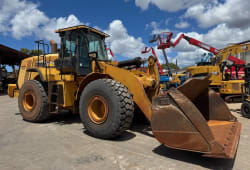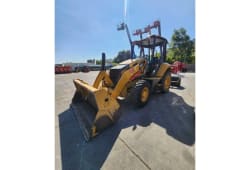Clear Operating Procedures: Ensuring Safety for Heavy Equipment Operators
12 Min read
)
August 11, 2023
Clear operating procedures are crucial for ensuring the safety of heavy equipment operators. These procedures provide a set of guidelines and instructions that operators can follow to carry out their tasks safely and efficiently. Understanding the importance of clear operating procedures is essential for both operators and organizations in the heavy equipment industry.
Understanding the Importance of Clear Operating Procedures
Operating procedures play a vital role in heavy equipment operations. They serve as a roadmap for operators, providing them with the necessary steps and precautions to perform their tasks effectively. With clear procedures in place, operators can minimize risks, prevent accidents, and protect themselves and others around them. Clear operating procedures also contribute to the overall efficiency and productivity of operations by ensuring consistency and standardization.
The Role of Operating Procedures in Heavy Equipment Operations
Operating procedures act as a guiding framework for heavy equipment operations. They outline the proper sequence of steps and actions to be taken when using various types of equipment. These procedures detail critical aspects such as equipment operation, maintenance, inspection, and emergency protocols. By following these procedures, operators can reduce the likelihood of equipment failure or malfunction, avoid injuries, and maintain a safe working environment.
When it comes to heavy equipment operations, safety should always be the top priority. Clear operating procedures provide operators with the necessary information to ensure safe and efficient operations. For example, the procedures may include instructions on how to properly start and shut down equipment, how to handle emergencies, and how to perform routine maintenance checks.
Moreover, these procedures also cover important aspects such as the use of personal protective equipment (PPE). Operators are instructed on the specific PPE they should wear, such as hard hats, safety glasses, gloves, and steel-toed boots, to protect themselves from potential hazards. By adhering to these guidelines, operators can significantly reduce the risk of accidents and injuries.
The Impact of Clear Procedures on Operator Safety
Clear operating procedures have a direct impact on operator safety. They provide operators with clear instructions on how to operate equipment safely, including safety precautions and rules to follow. Operators who have a thorough understanding of these procedures are better equipped to recognize potential hazards and take preventive measures. By adhering to these guidelines, operators can not only protect themselves but also their colleagues and the overall workplace environment.
Additionally, clear operating procedures also contribute to the overall efficiency and productivity of operations. When operators have a clear understanding of the steps they need to follow, they can perform their tasks more confidently and efficiently. This leads to smoother operations, reduced downtime, and increased productivity.
Furthermore, clear operating procedures promote consistency and standardization in heavy equipment operations. When all operators follow the same set of procedures, it ensures that tasks are performed uniformly across the organization. This consistency minimizes the risk of errors and improves the overall quality of work.
In conclusion, clear operating procedures are essential in heavy equipment operations. They provide operators with the necessary guidance to perform their tasks safely and efficiently. By following these procedures, operators can minimize risks, prevent accidents, and contribute to the overall productivity of operations. Organizations must develop and communicate clear operating procedures to ensure the safety and success of their heavy equipment operations.
Key Elements of Effective Operating Procedures
Effective operating procedures exhibit certain key elements that contribute to their efficacy in ensuring safety. They include:
Detailed Step-by-Step Instructions
Operating procedures should provide clear and detailed step-by-step instructions on how to carry out specific tasks using heavy equipment. These instructions should be easy to understand, logically organized, and include any necessary precautions or warnings.
For example, when operating a crane, the operating procedure should outline the precise sequence of actions required to safely lift and move heavy loads. It should include instructions on how to inspect the crane for any signs of damage or malfunction before the operation, how to position the crane for optimal stability, and how to properly attach and secure the load. By providing such detailed instructions, operators can perform their tasks with confidence and minimize the risk of accidents or equipment damage.
Inclusion of Safety Measures
:format(webp))
Any effective operating procedure should prioritize safety. It should specify the safety measures to be taken by operators throughout the equipment operation process. This may include wearing proper personal protective equipment, conducting pre-operation inspections, and following specific safety protocols for different tasks.
For instance, when operating a forklift, the operating procedure should emphasize the importance of wearing a hard hat, safety glasses, and a high-visibility vest. It should also outline the need to inspect the forklift's brakes, tires, and steering mechanism before use. Additionally, it should provide guidelines on how to safely maneuver the forklift, avoid obstacles, and stack loads stably. By incorporating these safety measures into the operating procedure, the risk of accidents, injuries, and property damage can be significantly reduced.
Regular Updates and Reviews
Operating procedures should be considered living documents that require regular updates to reflect changes in equipment, safety regulations, or industry standards. Regular reviews and updates ensure that procedures remain relevant, accurate, and aligned with the evolving needs and requirements of heavy equipment operations.
For example, if a new safety regulation is introduced that affects the operation of a specific type of equipment, the operating procedure should be promptly updated to incorporate the necessary changes. Similarly, if there are advancements in technology that improve the efficiency or safety of equipment operations, the operating procedure should be revised to reflect these advancements. By conducting regular reviews and updates, organizations can ensure that their operating procedures are up-to-date and effective in promoting safe and efficient heavy equipment operations.
The Role of Training in Implementing Operating Procedures
Comprehensive training plays a significant role in successfully implementing operating procedures. Proper training ensures that operators understand and follow procedures correctly, reducing the risk of accidents and injuries. It equips operators with the necessary skills to operate heavy equipment safely and efficiently.
Implementing operating procedures without adequate training can lead to serious consequences. Operators who are not properly trained may not be aware of the potential hazards associated with their tasks. They may not know how to use the equipment correctly, increasing the risk of accidents and property damage. In addition, operators who lack training may not be able to identify and respond to emergencies effectively, putting themselves and others at risk.
Importance of Comprehensive Training
Comprehensive training provides operators with a deep understanding of the operating procedures specific to their equipment and tasks. It covers theoretical knowledge, practical skills, and hands-on experience. Training programs should include both classroom instruction and practical training sessions to allow operators to apply their knowledge in a supervised setting.
During classroom instruction, operators learn about the principles and concepts behind the operating procedures. They gain knowledge about the equipment they will be operating, including its capabilities, limitations, and safety features. Classroom sessions also cover topics such as hazard identification, risk assessment, and emergency response procedures.
Practical training sessions are equally important as they provide operators with the opportunity to apply what they have learned in a real-world setting. These sessions typically take place in a controlled environment, such as a training facility or a designated practice area. Operators practice operating the equipment under the guidance of experienced trainers, who can provide feedback and correct any mistakes. This hands-on experience allows operators to develop their skills and build confidence in their ability to perform their tasks safely and efficiently.
Training Methods for Heavy Equipment Operators
Training methods for heavy equipment operators should be designed to maximize learning and retention. This can include a combination of classroom lectures, virtual simulations, practical demonstrations, and on-site training. Hands-on experience with the actual equipment under the guidance of experienced trainers is critical for operators to gain proficiency and confidence in operating heavy machinery.
Classroom lectures provide operators with the necessary theoretical knowledge. Trainers use visual aids, such as slides and videos, to explain concepts and procedures clearly and engagingly. Interactive discussions and question-and-answer sessions allow operators to clarify any doubts and deepen their understanding of the material.
Virtual simulations are increasingly being used in training programs to enhance the learning experience. These simulations recreate realistic scenarios that operators may encounter in their day-to-day work. By using virtual equipment and controls, operators can practice their skills in a safe and controlled environment. Simulations allow operators to learn from their mistakes without the risk of causing accidents or damage.
Practical demonstrations provide operators with a visual representation of the operating procedures. Trainers showcase the correct techniques and best practices, highlighting safety considerations and potential pitfalls. Operators can observe and learn from these demonstrations, gaining insights into the proper execution of tasks.
On-site training is crucial for operators to become familiar with the specific equipment they will be operating. This training takes place at the actual work site, allowing operators to practice in the environment where they will be performing their tasks. Trainers can assess operators' performance and provide guidance tailored to the specific challenges and conditions of the site.
In conclusion, comprehensive training is essential for the successful implementation of operating procedures. It ensures that operators have the knowledge, skills, and confidence to perform their tasks safely and efficiently. By investing in proper training, organizations can minimize the risk of accidents, protect their employees, and enhance overall productivity.
Case Studies: The Consequences of Unclear Operating Procedures
Real-life incidents can serve as stark reminders of the importance of clear operating procedures. Lack of clarity in procedures can have severe consequences, leading to accidents, injuries, and even fatalities.
In one notable case, a construction site experienced a devastating accident due to unclear operating procedures. The incident occurred when a crane operator misunderstood the instructions for lifting a heavy load. As a result, the load was not properly secured, causing it to swing uncontrollably and collide with nearby structures. This unfortunate incident resulted in significant property damage and multiple injuries to workers.
Real-life Incidents Due to Lack of Clear Procedures
There have been instances where unclear or inadequate operating procedures have resulted in accidents. These incidents have often occurred due to misunderstandings, miscommunications, or the absence of proper guidelines. In some cases, operators were not fully aware of the potential risks associated with specific tasks, leading to negligence and unintended consequences.
Another incident that highlights the consequences of unclear operating procedures occurred in a manufacturing plant. Due to a lack of clear instructions, a worker accidentally mixed incompatible chemicals, resulting in a chemical reaction that caused a hazardous release of toxic fumes. Several employees were exposed to the fumes, leading to severe respiratory problems and the need for immediate medical attention.
Lessons Learned and Improvements Made
Organizations have learned valuable lessons from these incidents and have worked towards enhancing safety standards. Lessons learned from accidents have been used to identify areas for procedure improvement, highlighting the need for clearer instructions, increased training, and better communication between operators and management.
In response to the crane accident, the construction company implemented a comprehensive training program for crane operators. The program focused on reinforcing the importance of understanding and following operating procedures, as well as providing practical scenarios to enhance decision-making skills. Additionally, the company revised its operating procedures, ensuring that they were concise, easy to understand, and prominently displayed at the worksite.
Similarly, the manufacturing plant took immediate action to prevent future incidents. They conducted a thorough review of their chemical handling procedures, identifying areas where clarity was lacking. As a result, they implemented a color-coded labeling system for all chemicals, provided additional training on proper mixing and handling, and established a clear reporting process for any potential hazards.
These improvements have contributed to safer and more efficient operations within the heavy equipment industry. By prioritizing clear operating procedures and learning from past incidents, organizations can minimize the risk of accidents, protect the well-being of their employees, and ensure the smooth functioning of their operations.
Best Practices for Developing Clear Operating Procedures
Developing clear operating procedures requires careful consideration and involvement from all stakeholders. There are several best practices that organizations can adopt to ensure the effectiveness of these procedures.
Involving Operators in Procedure Development
Operators who are directly involved in the equipment operations should have a say in developing the operating procedures. Their knowledge and experiences are invaluable in identifying potential risks and suggesting improvements. This collaborative approach promotes ownership, enhances understanding, and increases compliance with the established procedures.
Utilizing Visual Aids and Clear Language
Using visual aids such as diagrams, illustrations, and photographs can greatly enhance the clarity of operating procedures. Visual representations help operators better understand complex instructions, highlight crucial steps, and improve overall comprehension. Additionally, using clear and concise language, free from technical jargon, ensures that procedures can be easily understood by operators with varying levels of experience and expertise.
Regular Audits and Feedback
Regular audits and feedback mechanisms are essential for ensuring the continuous effectiveness of operating procedures. Conducting routine checks and inspections allows organizations to identify areas for improvement or potential deviations from established procedures. Collecting feedback from operators and incorporating their suggestions fosters a culture of continuous improvement and helps address evolving safety concerns.
The Future of Operating Procedures in Heavy Equipment Operations
The heavy equipment industry is continuously evolving, and advancements in technology are shaping the future of operating procedures.
Technological Advancements and Their Impact
Technological advancements, such as the integration of sensors, telematics, and automation, are revolutionizing heavy equipment operations. These technologies can enhance safety by providing real-time data, detecting potential hazards, and enabling remote monitoring and control. Operating procedures will need to adapt to incorporate these technological features while ensuring that operators maintain a crucial role in decision-making and maintaining situational awareness.
The Role of Continuous Improvement in Safety Procedures
Continuous improvement is vital for the ongoing effectiveness and relevance of operating procedures. As new challenges emerge, such as changes in regulations or the introduction of new equipment, procedures must be regularly reviewed, updated, and communicated. This ongoing commitment to improvement ensures that heavy equipment operators can undertake their tasks with the highest level of safety and efficiency.
Clear operating procedures are the backbone of safety in heavy equipment operations. They provide a comprehensive set of instructions and guidelines that operators can follow to protect themselves, their colleagues, and the workplace environment. By understanding the importance of clear procedures, organizations can establish a culture of safety and empower operators to perform their tasks confidently and effectively. With ongoing training, regular reviews, and a commitment to continuous improvement, operating procedures will continue to play a crucial role in ensuring the safety of heavy equipment operators now and in the future.

Caleb Woods is an experienced content specialist and an editor at Boom & Bucket, blending his journalism background with expertise in the heavy equipment industry. He delivers engaging, informative content to help professionals stay informed and make smarter decisions in the machinery market.














